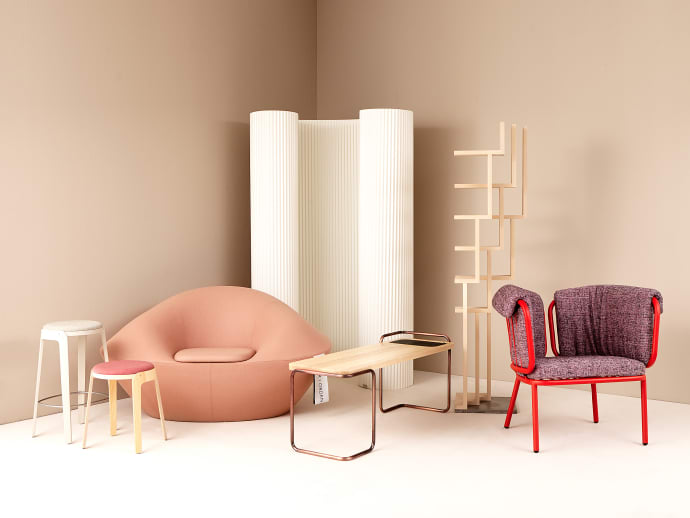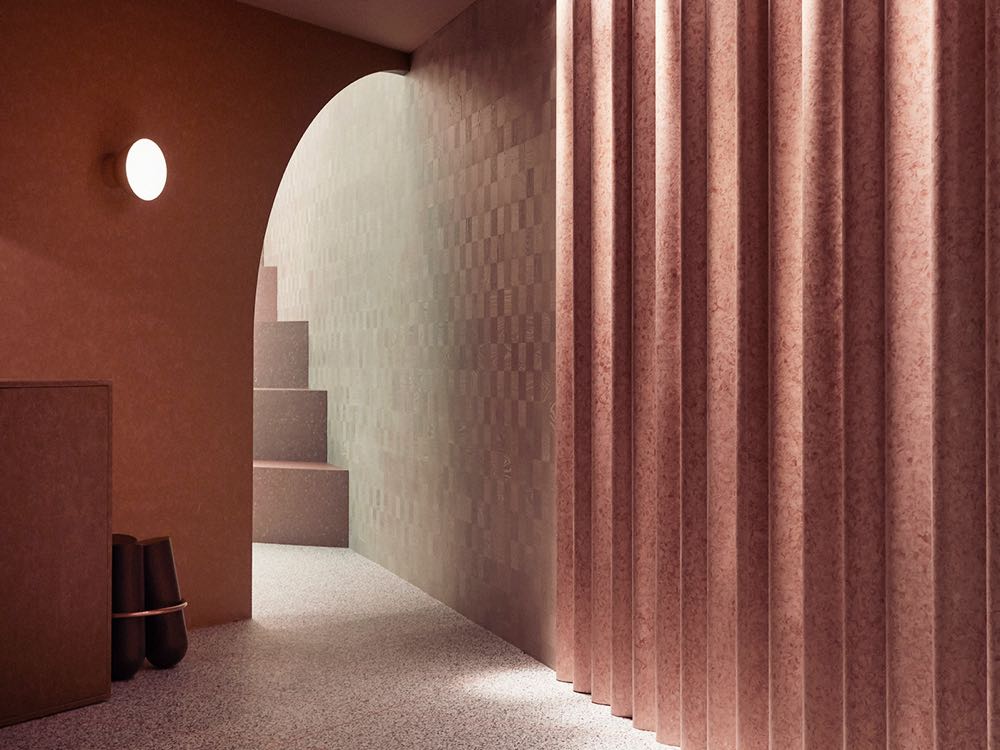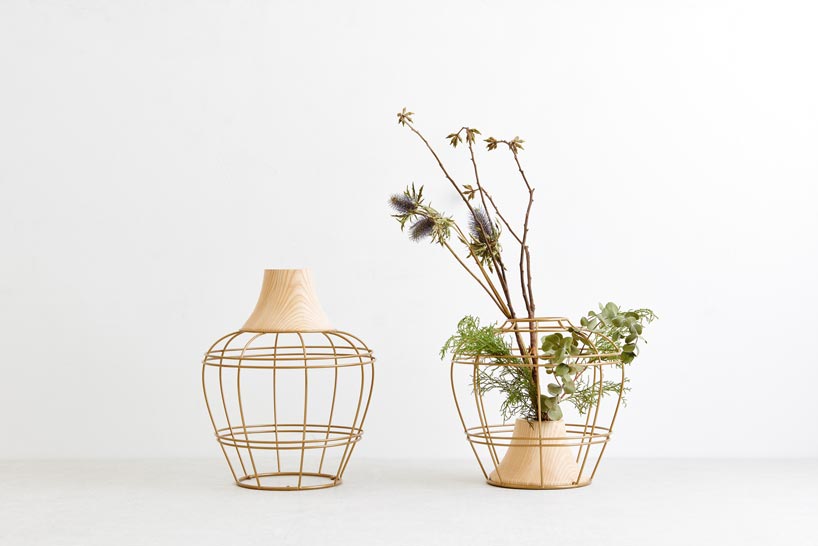The Stockholm Furniture & Light Fair has become a key destination in the design calendar with what feels like a veritable wave of great work from Scandinavian and Nordic designers capturing the world's attention. That's not to say that the fair is exclusively for designers and manufacturers from Denmark, Sweden, Finland and Norway. Designers from countries like Germany, Taiwan, Canada and even Australia were in evidence showing their work along side manufacturers from all over the world. Somehow despite the global nature of the fair it manages to retains its Northern European roots with a strong emphasis on traditional craft and natural materials.
Ariake is relatively new but what this Japanese brand lacks in age it makes up for in it's tremendous taste in the choice of designers and art direction it uses. With names like Staffan Holm, Norm Architects, Anderssen & Voll and Studio MK27 on their roster of collaborators, its no wonder that their installation A Quiet Reflection was so widely talked about. It didn't hurt that the address was kept secret until a couple of days before the launch and that the building was from the late nineteenth century with just the right level of decay and clever intervention to make it completely intriguing.
A coming together of the resources of two Japanese companies Legnatec and Hirata Chair from the furniture town of Morodomi in Saga Prefecture, the new brand has certainly got just about everything right. While dozens of excellent Japanese furniture companies exist, most are unable to convert the quality of what they produce into a brand image with global appeal. Among the thirty designs that now make up the collection were several new pieces such as the 'Braid' collection of sofas and armchairs by Norm Architects (shown above). Combining solid wood with tatami mat materials, the collection reinforces the brand's synergy of Asian and Scandinavian aesthetics. Shin Azumi, Keiji Ashizawa and the brand's Creative Director, Gabriel Tan are among the non-European designers represented.
While every fair has its knockout stands (this year at Stockholm it was the Tarkett stand by Note Design) and slick presentations, its often the young designers section that create some of the most intimate connections. Beckmann staged an exhibition called 'Hear Us Out' where twelve of their graduating designers were asked to pair up and work with a manufacturer to design and prototype a piece. The six completed designs were made by some of Sweden's premier furniture producers: Blå Station, Gärsnäs, Johanson Design, Källemo, Mass Productions and Materia. Shown above from left to right are the 'Fransson' stools by Anna Hermann & Lisa Jonsson for Garsnas, the 'Fortuna' armchair by Hanna Stenström and Jenny Aden for Materia, 'Kolonn' by Klara Helengren and Lisa Lindh for Mass Productions, the 'Kaj' bench by Celine Strömbäck and Ida Björses for Blä Station, 'Arbor' shelf by Madeleine Nelson and Frida Pettersson for Källemo and the 'Vent' chair by Sarah Hasselqvist and Melinda Urbansdotter for Johanson Design for Johnson Design.
The designs broke some new ground with the first room divider completely made from cellulose fiber ('Kolonn' by Klara Helengren and Lisa Lindh for Mass Productions) and perhaps the first chair inspired by a Chinese cookie - the 'Fortuna' armchair by Hanna Stenström and Jenny Aden for Materia. The later is a personal favourite. Design daily is not usually drawn to bulbous rounded armchairs with no legs (okay except perhaps Mario Bellini's 'Le Bambole' and its contemporary cousin 'MIA' from MDF Italia) preferring crafted timber designs in the main but this particular example of the moulded foam genre is quite irresistible.
Tarkett is the global leader in vinyl flooring and one of the biggest in the world in flooring in general. The collaboration with Note Design allowed the brands products to be showcased in exciting new ways using geometric shapes in sophisticated tones punctuated by flashes of vibrant colour. The stand won Best Stand in the Editors Choice Awards.
Also part of the Greenhouse mentioned earlier were two Chinese Canadian designers based in Toronto, Topher Tong and Stein Wang. The duo were nominated for the Rising Star Award showing their 'O' collection of six pieces in matching forest green. With Hi Thanks Bye as their studio name, the two obviously have a good sense of humour but their work was anything but comic or cartoonish, drawing influences from traditional Chinese furniture shapes and the beauty of Canadian islands like Fogo. You can see some line drawings of the entire collection here
Copenhagen based Australian designer Nicolai Kotlarczyk has gained attention in recent times for his beautifully detailed mirrors called 'Scena' for young Italian design company Portego. Showing at the Greenhouse this year with Danish designer Troels Flensted, his new work 'Grain Console' followed his interest in the alteration of reflective materials found in 'Scena' but in a much more graphic way. His 'Barocche' design from 2017 (below right) also uses oxidised and polished brass in patterns but in this instance based on a amalgamated floor plan of several Catholic churches. The chair shown on the left directly below is a new prototype called 'Wompoo'. It was inspired by the Australian Bird of Paradise flower.
Danish Design MAKERS is a large collective of designers from a variety of backgrounds and nationalities founded by Antonio Scaffidi, Øivind Alexander Slaatto (designer of the B&O BeoPlay 9) and Thomas Albertson. DDM collaborate to advance each others individual projects. The experience and particular skills of each member of the group aids the development of new ideas and helps speed up prototyping. This year's exhibition "A tribute to everyday life", featured work from 22 designers, and looks into an everyday routine from their own private lives. The images below are by Kristine Funch & Emilia Therese and include Studio FEM's 'Every Chair', Nordvink's 'Urt' - a colourful plastic watering jug and herb planter box, Rikke Frost's 'Re- Hang' bed room set and Isabel Ahm & Signe .O. Lund's 'Prima Ballerina' cabinet which is designed to store shoes.
Swedish company Fogia has rapidly become one of the hottest tickets in town during Stockholm Design Week. Over the last two years the brand has been transformed by the design input of Note Design Studio, Andreas Engesvik, Luca Nichetto and Norm Architects.
Fogia also released a new chair called 'Myko' designed by Stefan Borselius. The upholstered side chair features a unique fashion-inspired upholstery detail on the back. The pinched pleat waist is a strong feature in leather but much more subtle in fabric. The chair is available with a metal or timber base for two extremely different looks - the metal version offered with or without wheels.
Not settling for just three amazing new releases, Fogia also launched Luca Nichetto's new 'Mame' - a deeply enveloping armchair shown below on a metal base and the 'Enclose' chair by Norm Architects made with two interlocking upholstered shells on a traditional looking Scandinavian timber base. Both chairs offer a nod to armchairs from the past from their respective countries (Italy & Denmark) but offer new proportions and details. The brand also released a metal shelf called 'Hawu' and side table 'Gito' both by young Swiss studio Diiis.
ADEA is another Finnish brand that had escaped Design daily's attention until researching this year's Stockholm fair. The company has been going for twenty years but recent new designs like the 'Plateau' tables and sofas 'Bon' 'Baron' and 'Bonnet' (whats with the obsession with names starting with 'B'?) by Mats Broberg & Johan Ridderstråle have transformed its formerly conservative image. Joining the collection at Stockholm this year were new furniture pieces by Mia Cullen, Anika Gneib and Alexander Lervik. New lighting was also in evidence from young designer Anni Pitkäjärvi of Studio Finna.
Below are the new 'Napoleon' sofa and armchair collection by Anika Gneib and the 'O' pendant by Anni Pitkäjärvi. The 'Napoleon' collection references a mathematical shape known as the bicon curve, also known less formerly as the cocked hat curve! This shape was made famous by Napoleon Bonaparts' hat which coined the collection's name. The 'O' pendant was shown as a prototype at Satellite at Salone del Mobile in Milan last year on the Studio Finna stand. The light is made from shaped birch plywood with a blackened exterior.
Natural materials is a theme that constantly raises its head at the Stockholm fair. The 'Flik Flak' lamp by Snøhetta in collaboration with Swedish lighting company ateljé Lyktan takes a form that bears a striking resemblance to Barber Osgerby's 'Tab' lamp for Flos but reinterprets the shape using simple materials and mechanisms - two flaps of birch ply and a piano hinge. Within the simple shade is an LED light source. The 'Font Regular' chair by Studio David Thulstrup for Mobel brings together a quasi dining / arm chair with exaggerated horseshoe shaped arm and tactile woollen boucle fabric. A 'no touching' sign would be a waste of time with this chair.
Jenny Nordberg is an exploratory and interdisciplinary designer based in the south of Sweden. Her work ranges from investigations into the use of standardised materials for plant pots to the irregularities that can be purposefully introduced into production furniture and everything in between. Her Brick candle holders harken back to the work of Timo Sarpaneva and his 'Festive' candlesticks and glassware for Iittala but are rather more industrial in origin. The dimensions of the glass segments used for the candleholders are exactly based on standard traditional bricks. Cast in an Italian glass factory the candleholders are hand assembled and sold through Malmo based brand Swedish Ninja as production pieces and as limited edition pieces through Stockholm Modern - a Stockholm design gallery.
Pholc are a Swedish lighting brand established in 2015. Their new 'Apollo' pendant lights shown below are designed by Broberg & Ridderstråle and come in three sizes 39, 59 and 75cm in dirty versions of primary colours or in subdued tones of white and grey.
Design daily liked this chair from the moment it was previewed but when we saw this wonderfully exotic photograph the love was confirmed. The chair has strong fifties overtones but seems able to cope with these extraordinary surrounds undaunted. Much like a contemporary reworking of the IB Kofod Larsen, 'Shell Back' or 'Penguin' chair from the 1950's, the 'Lassen' chair is comfortable and inviting but light on its feet.
Taiwanese designers Kimu Studio offer a beautiful contemporary take on traditional Asian objects. Their new range of paper lanterns are perhaps the most striking but equally poetic is their 'New Old Vase' shown below. The paper lanterns are an addition to a previous collection but have grown in refinement from an industrial pendant with paper diffuser to something quite exquisite. All their products show the same poetic quality that first came to world attention with their 'New Old Divider' a few years ago. The room divider uses a basic pivoting metal frame but incorporates the clever use of fabric fans. Take a look at their wonderful work here.
Shown below are Kimu Studio's 'Nigiri' floor lamp (left) and 'Landscape' floor lamp (right). Both lamps use traditionally made paper shades to create soft glowing light while stripping back the structure to its fundamental elements.
While on the topic of beautifully minimal lighting it was impossible to go past the inclusion of Le Klint's latest collection 'Arc' by Nanna Neergaard and Marie Hesseldahl under the name Manér Studio. Launched last year the design references the interior of Grundtvigs Church in Copenhagen and is now readily available although it appears the curved wall mounted lamp is sadly not yet in production.
The repeating arc pattern is incredibly effective and moves the traditional Danish lighting company into a completely new and exciting area.
Danish brand &Tradition is back with several beautiful new products including the 'Pavilion' chair by Anderssen & Voll and the 'Journey' lights by Signe Hytte. &Tradition also showed their other new chair the 'Loafer' a fully upholstered chair by Space Copenhagen (seen in yellow peeking out from behind the 'Pavilion' chair).
New Danish lighting brand Nuura launched a large collection of lights including the 'Blossi' table light seen below (part of a huge collection covering just about every conceivable category of light) and the Miira 6 pendant. The entire collection is designed by Sofie Refer a Danish designer who graduated from the Danish Design School and is now partner and Creative Director of Refer + Staer Aps, a lighting design consultancy. She has previously designed several lights for &Tradition with the hugely successful 'Mega Bulb' being her most well known design.
One of Design daily's favourite Swedish designers is David Ericsson. His ability to bring out delicacy and poise in a chair is second to none. This year he followed up his wonderful 'Madonna' chair for Gärsnäs with an equally beautiful side chair called 'Petite'. What makes this chair so perfect is the absence of anything extraneous. The one super special detail existing at the back of the chair where the back rest is made from carved solid beech and formed beech plywood to encapsulate the rear legs. The result is very pretty while remaining simple and with subtle expressions of traditional craft. Ericsson was awarded Designer of the Year 2018 from FORM magazine.
“I have tried to rationalise away all unnecessary areas to reduce the number of components. It gives the chair a cleaner style, while also making it easier to build and uses resources more efficiently.”
David Ericsson
That's the last of the big international fairs until Milan in mid April when Design daily will be bringing you its usual excessive but thorough coverage of all things great and good in furniture, lighting and interior accessories.









































